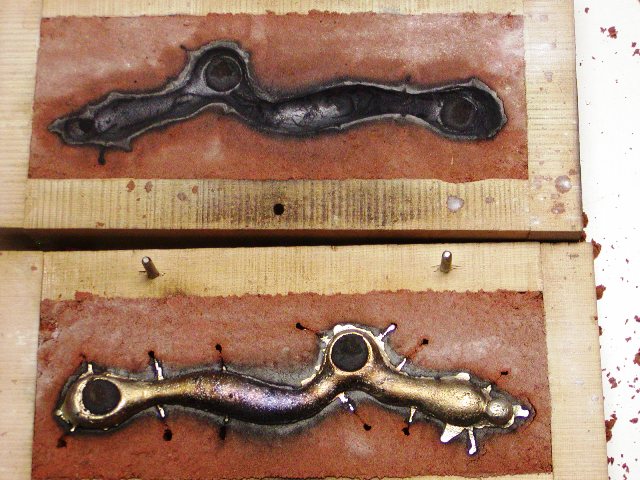You are using an out of date browser. It may not display this or other websites correctly.
You should upgrade or use an alternative browser.
You should upgrade or use an alternative browser.
Colonial American militia musket: in progress
- Thread starter dave_person
- Start date

Help Support Muzzleloading Forum:
This site may earn a commission from merchant affiliate
links, including eBay, Amazon, and others.
Doc Ivory
45 Cal.
Wow!
Just stumbled on this.
What a super job.
Just stumbled on this.
What a super job.
- Joined
- May 6, 2014
- Messages
- 17,493
- Reaction score
- 16,608
Hi,
I did not discuss this previously. My lock copies a commercial British Bess lock. As such, it is a little smaller in all dimensions. I bought an early convex Brown Bess sideplate from TOW meant to mate with a pattern 1730s Bess lock. My modified lock is sufficiently smaller such that the lock bolt holes no longer fit, which shows how dumb I can be. I had to downsize the plate a little. I cut off the original plate at the narrow behind the forward lock bolt, shortened the plate to allow for casting shrinkage, soldered the pieces together and used them to make a mold. Using Delft clay, I made the mold and cast the part. The result was perfect.
dave

Dave,
I'm glad Doc brought this thread up again, because I missed your theory that British Ordnance used drilling guides on the lock plates to match the cast side plates.
I'm particularly fascinated how British Ordnance purchased locks, barrels, other parts and "Walnut Tree Plank", sometimes over a few years while they built up the parts, and from a sundry assortment of different makers and found a way to make it all work - in a time period before the Interchangeable Parts System was successfully implemented.
Bailey mentions the locks were supplied to British Ordnance for inspection PRIOR to them being hardened. Once they passed muster, the lock plates were stamped with an Inspector's mark and sent to engravers to have the King's Cypher, the decorative double “border lines,” either Tower or Dublin Castle, and for a little over the first half of the 18th century, the date was also engraved. It has been mentioned that after the lock plates were so engraved, they were returned to British Ordnance for hardening/annealing. Though not normally mentioned, I suspect they drilled and tapped the "Side Nail" holes in the lock plate before hardening as well.
Though they may have had drill guides for drilling the Side Nail holes in the lock plate, I wonder if that may be too modern of thinking for most of the 18th century? After all, drill guides may have required more precision made drill bits than they could make at the time or at least too expensive to make when something else could have been used? Or is it possible that they did not actually drill through the drill guides, but maybe scribed around the holes with the drill plate against the lock and took the drill plate off and then drilled the holes?
Though Bailey says British Ordnance always saved the brass parts when they "broke up" unserviceable muskets to melt them down for newer parts, they also got a lot of castings from outside suppliers. However what you experienced with having to re-cast the Side Plate for this Musket to “agree” with the holes in the Lock Plate, got me to thinking British Ordnance had to have had some way of ensuring rather extreme “uniformity” in the way Side Plates were cast so the heads of the “Side Nails” wound up in the center of places in the rounded Side Plates, that were countersunk for the heads of the “Side Nails.”
At first, I thought British Ordnance would have had to have supplied some kind of Gauge to outside casting businesses, so the Side Plate castings they supplied would thus “agree” where they would need to drill the holes for the Side Nails and have enough metal around the heads to countersink the heads of the screws. However, another look at “The Brown Bess” by Goldstein and Mowbray at least suggests British Ordnance came up with an even easier way to do that. They MAY have cast ALL the Side Plates for the P1730 through P1748 Muskets and other Arms during that period in their own Ordnance Shops. On Page 24, they show a Side Plate with two Side Nails in it and with the following caption, “Note the view at the above left, showing a broad arrow mark accompanied by an “H” for Thomas Hollier, the Ordnance’s tenant at Armoury Hills until his death in 1754.” Hollier’s mark also is shown on a Side Plate in the chapter on the P1748 Musket.
Now I’m pretty sure Thomas Hollier didn’t cast ALL the Side Plates himself for the Tower Arms during those years and more likely he was in charge of a group of founders who did cast them all in the Ordnance workshops. However, it seems British Ordnance came up with a rather elegant method to ensure the Side Plates would agree with the holes in the Lock Plates, long before the age of the Interchangeable Parts System.
Gus
Sam squanch
69 Cal.
- Joined
- Oct 9, 2019
- Messages
- 3,305
- Reaction score
- 4,733
Wow! That is one nice musket! One question, Dave , do you ever sleep?
Similar threads
- Replies
- 31
- Views
- 2K
- Replies
- 95
- Views
- 4K



